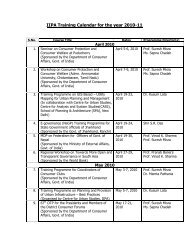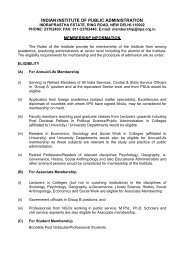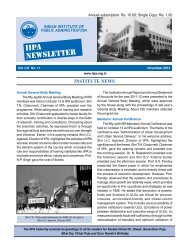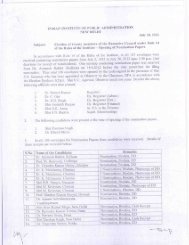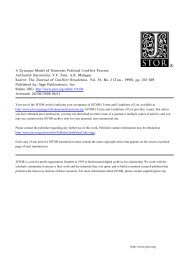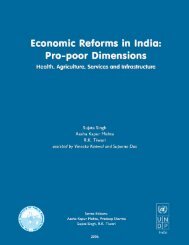Privatisation of Health Care in India - Indian Institute of Public ...
Privatisation of Health Care in India - Indian Institute of Public ...
Privatisation of Health Care in India - Indian Institute of Public ...
- No tags were found...
You also want an ePaper? Increase the reach of your titles
YUMPU automatically turns print PDFs into web optimized ePapers that Google loves.
<strong>Privatisation</strong> <strong>of</strong> <strong>Health</strong> <strong>Care</strong> <strong>in</strong> <strong>India</strong>globalised middle class <strong>of</strong> pr<strong>of</strong>essionals, who had bothurban and rural roots, was beg<strong>in</strong>n<strong>in</strong>g to emerge. The aspirations<strong>of</strong> this class were clearly different from the largesection <strong>of</strong> the poor. Typically the ‘new middle class’ foundthe public system <strong>in</strong>adequate to meet their needs and <strong>in</strong>those states where there was a vibrant private sector theystarted mov<strong>in</strong>g out <strong>of</strong> the public sector. This is seen <strong>in</strong> thecase <strong>of</strong> health service utilisation dur<strong>in</strong>g the mid-eightieswhere<strong>in</strong> the urban and rural middle-<strong>in</strong>come groups utilisedprivate health services depend<strong>in</strong>g on their ability to pay.Here it is important to underscore the fact that there areregional variations and this trend is seen <strong>in</strong> the richer statesas compared to the poorer ones (Baru, 1998). The mov<strong>in</strong>gout <strong>of</strong> upper and middle sections <strong>of</strong> the populationfrom public provision<strong>in</strong>g had serious consequences for f<strong>in</strong>anc<strong>in</strong>g,provision<strong>in</strong>g and quality <strong>of</strong> services. These sectionsreally provide the constituents for the support <strong>of</strong>health sector reforms and support the neo liberal position thatpublic services are for the poor and those who can afford topay should use private services. With the middle class giv<strong>in</strong>g upownership <strong>of</strong> the public sector there is a further weaken<strong>in</strong>g <strong>of</strong>the state’s commitment towards public provision<strong>in</strong>g.<strong>India</strong>, with its fairly significant middle class provides a goodmarket for mult<strong>in</strong>ationals 2 . Computer s<strong>of</strong>tware <strong>in</strong>dustrytie-ups with the medical sector and American <strong>in</strong>surancecompanies look<strong>in</strong>g for tie-ups will further consolidate theposition <strong>of</strong> global capital <strong>in</strong> the private health sector. Thiswould def<strong>in</strong>itely redef<strong>in</strong>e and alter the spaces for the statesto plan their health services. These trends are not restrictedto the private sector, but with the restructur<strong>in</strong>g <strong>of</strong> the publichospitals under the health sector reforms, the <strong>in</strong>terests <strong>of</strong>some <strong>of</strong> these <strong>in</strong>dustries, especially, the medical equipment<strong>in</strong>dustry would grow.2McK<strong>in</strong>lay (1980) has observed that for any substantive analysis <strong>of</strong> privatisation <strong>of</strong> health services there needs to be recognition <strong>of</strong> the role played bylarge f<strong>in</strong>ance capital <strong>in</strong> the health sector. Large f<strong>in</strong>ance capital was largely conf<strong>in</strong>ed to the pharmaceutical, medical equipment and <strong>in</strong>surance<strong>in</strong>dustries and these operated globally. The impact <strong>of</strong> these <strong>in</strong>dustries was very visible <strong>in</strong> the <strong>India</strong>n case dur<strong>in</strong>g the late eighties and n<strong>in</strong>eties whenthere was a sharp <strong>in</strong>crease <strong>in</strong> the import <strong>of</strong> medical equipment. The real peak was seen dur<strong>in</strong>g the mid to late n<strong>in</strong>eties with the government <strong>of</strong>fer<strong>in</strong>greduced import duties for medical equipment (Baru, 1998). Apart from imports, many mult<strong>in</strong>ational equipment companies like Siemens, Philips,Becaton and Dick<strong>in</strong>son and General Electric started sett<strong>in</strong>g up assembl<strong>in</strong>g plants <strong>in</strong> the central and southern parts <strong>of</strong> <strong>India</strong>. As an executive <strong>of</strong> PhilipsInternational remarked “The health care bus<strong>in</strong>ess is a $3000 billion <strong>in</strong>dustry worldwide. If even we attract one percent <strong>of</strong> the market <strong>in</strong> <strong>India</strong>, thepotential for the medical equipment <strong>in</strong>dustry is tremendous” (Baru,1998).10




